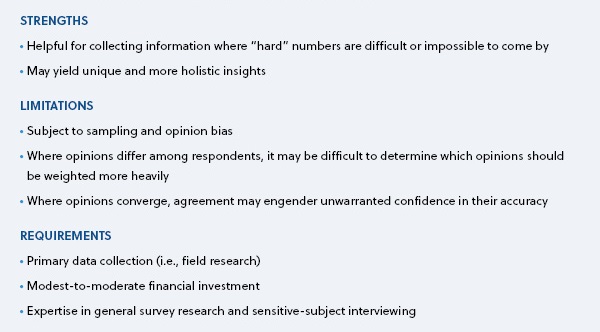What are the characteristics of consumers, producers, and/or distributors?
What are the characteristics of consumers, producers, and/or distributors?
Population-Based Surveys


Population-based surveys are well suited for gathering information about the consumers of unrecorded alcohol on a number of dimensions, including:
- behavioral (e.g., consumption patterns);
- socio-demographic (e.g., age, sex, income, employment / occupation status);
- attitudinal / perceptual (e.g., regarding the safety of unrecorded products and the social acceptability of consuming unrecorded products);
- motivational (e.g., reasons for consuming unrecorded products);
- social / contextual (e.g., consumption habits of friends and acquaintances); and
- knowledge (e.g., about the products that are consumed and the relevant policies).
It is important to recognize that the value of information gleaned from such surveys is diminished when consumers of unrecorded alcohol in the sample are not accurately identified (e.g., due to deceptive responding) or are underrepresented in the sample because of characteristics that make them more difficult for survey researchers to reach (e.g., homelessness when conducting a household survey). The more closely the sample of unrecorded consumers included in a survey approximates the entire population of unrecorded consumers, the more accurate the conclusions drawn from the data obtained.
Interviews with Key Informants


Interviews with key informants such as producers and distributors of unrecorded alcohol can yield insights into the characteristics of these groups. However, because reaching these individuals may be difficult ― and potentially dangerous ― appropriate caution should be taken when deciding whether and how to engage in such activities. Potential interviewees may be identified through store visits, by consumers of unrecorded alcohol, or by other producers or distributors. Key informants should not, however, be assumed to be representative of producers and distributors as a whole since it is likely that the characteristics that make them easier to locate, or more willing to be interviewed, also distinguish them in one or more ways from the larger population of those involved in producing and distributing unrecorded alcohol.
Interviews with key informants may also generate information about consumers, particularly those with whom they regularly interact. Again, considerable caution should be exercised when extrapolating information from these interviews to an entire population of unrecorded consumers.
